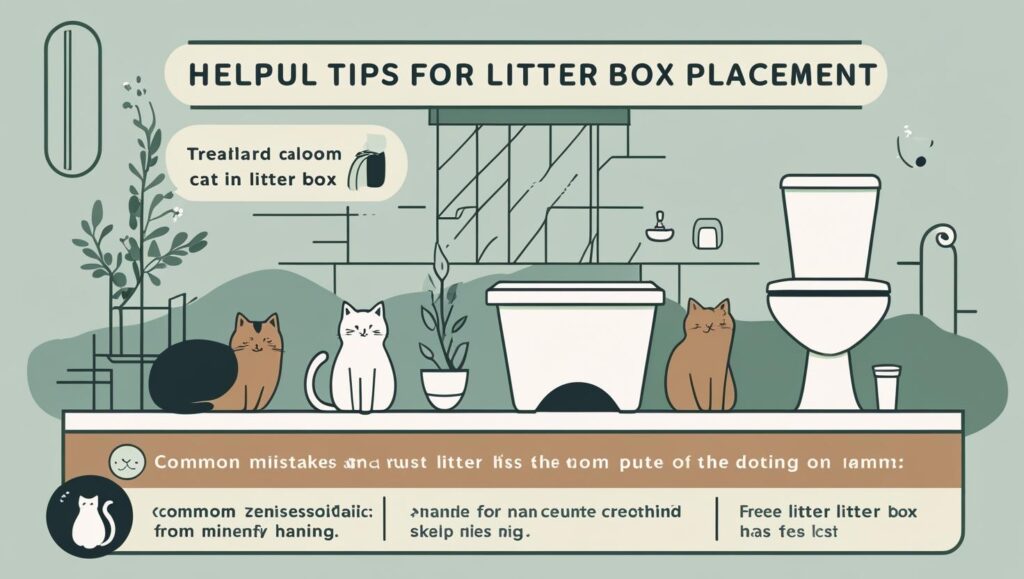
The short answer to can i move my cats litter box is yes, you can move it—but only if you do it correctly. Cats are creatures of habit, and sudden changes in their environment—especially something as essential as their bathroom—can upset them. If you plan wisely and follow gradual steps, your feline will adjust smoothly, avoiding stress or accidents.
Many pet parents worry about scenarios like “If I move my cats litter box will she find it?” or complain “I moved my cats litter box and now she won’t use it.” The truth is, these problems are avoidable once you understand how cats rely on scent, territory, and routine.
This guide breaks down everything you need to know about moving, training, and troubleshooting—from finding the Best (and Worst) Spots for Your Cat’s Litter Box to learning How to Train a Cat to Use a Litter Box in a New Location.
Table of Contents
Do Cats Get Upset If You Move Their Litter Box: can i move my cats litter box
Yes, most cats do get upset when their litter box is moved suddenly. Cats are highly territorial and depend on consistency in their environment. A litter box is more than just a toilet—it’s part of their comfort zone and territory marker. When it shifts unexpectedly, some cats interpret this as a disruption or even a threat, which can cause stress-related behaviors.
Why Cats Get Upset
- Loss of familiar scent → The old spot carries their smell, which reassures them.
- Change in routine → Cats thrive on habit; sudden change makes them anxious.
- New environment threats → If the new spot feels noisy, bright, or unsafe, they may refuse to use it.
- Age or health factors → Older cats or those with mobility issues may find the new spot harder to reach.
How to Prevent Upset
- Move Gradually – Shift the box a few feet at a time over several days.
- Double Box Strategy – Place a second box in the new location while leaving the old one temporarily.
- Scent Familiarity – Mix a little used litter from the old box into the new one.
- Positive Reinforcement – Guide your cat to the new box after meals and reward with praise or treats.
- Avoid Stressful Locations – Don’t place it near loud appliances, next to food, or in high-traffic areas.
What If My Cat Gets Upset Anyway?
If your cat stops using the litter box, don’t panic. Place a box back in the original location for a short period, then retry moving it slowly.
Will Cats Find Their Litter Box If You Move It?

Most cats will eventually find their litter box if you move it, but the success depends on how far, how fast, and how familiar the new location is. Cats rely heavily on scent memory, territorial instincts, and routine. If the move is sudden, some cats may struggle, leading to confusion or accidents.
Factors That Affect Whether Cats Will Find It
- Distance of the Move – Moving the box across the same room is easier than relocating it to a new floor.
- Scent Familiarity – Cats use smell as their GPS. If the new box has no scent, they may ignore it.
- Noise and Safety – If the new spot feels unsafe (near washing machines, heaters, or noisy hallways), cats may avoid it.
- Age & Health – Kittens explore more easily, while seniors or anxious cats may resist.
- Multi-Cat Homes – Other pets may block or intimidate access to the new spot.
How to Help Your Cat Find the New Litter Box
- Show Them the Spot – Gently place your cat in the new box after meals or naps.
- Keep Old Litter – Mix a scoop of used litter from the old box into the new one.
- Two-Box Strategy – Leave the old box in place temporarily while introducing the new one.
- Use Pheromone Sprays – Products like Feliway can reduce anxiety and encourage use.
- Encourage Exploration – Let your cat roam freely to discover the new location without being forced.
Common Problems Owners Report
- “I moved my cats litter box and now she won’t use it.” → Usually caused by rushing the move.
- “My cat peed on the carpet after moving the box.” → A stress response to unfamiliar territory.
- “Can cats find their litter box in the dark?” → Yes, but senior cats may need night-lights.
Should a Litter Box Be Next to Bed?
Placing a litter box directly next to your bed is not recommended. While it might feel convenient in a small apartment or studio, it can create issues for both you and your cat. A litter box is a cat’s private bathroom space—and putting it too close to sleeping or eating areas can cause hygiene problems, stress, and even refusal to use the box.
Why the Bedroom Isn’t Ideal
- Hygiene Concerns – Dust, odor, and bacteria from cat litter can affect air quality where you sleep.
- Sleep Disturbances – Cats often scratch, dig, or use the box at night, creating unwanted noise.
- Lack of Privacy – Cats prefer quiet, low-traffic areas to do their business. A bed nearby might feel too exposed.
- Behavior Issues – If the bed area feels unsafe (due to humans moving, noise, or scent), your cat might avoid the box.
What To Do If You Have Limited Space
In small homes or studio apartments, you may have no choice but to place the box in or near your bedroom. If so:
- Use a covered litter box with good ventilation.
- Add an air purifier or odor-control product nearby.
- Place it as far from your bed as possible within the room.
- Consider screen dividers to separate the space.
- Regularly clean to prevent odors and bacteria buildup.
Common Mistakes Cat Parents Make
- Putting the box right next to the bed frame for convenience.
- Not scooping often enough, leading to strong odors.
- Using scented litter, which may bother both you and your cat.
Bottom Line
While you can place a litter box in the bedroom if space is limited, it’s not ideal for hygiene, sleep, or your cat’s comfort. The best approach is to choose a quiet, ventilated area slightly away from sleeping or eating spaces. If the bedroom is your only option, use odor-control solutions, barriers, and extra cleaning to make it safe and comfortable for both you and your cat.
What Is the Litter Box Rule for Cats?
The litter box rule for cats is simple but powerful: one litter box per cat, plus one extra.
This formula prevents stress, territorial disputes, and “accidents” outside the box. For example:
- 1 cat → 2 litter boxes
- 2 cats → 3 litter boxes
- 3 cats → 4 litter boxes
This rule isn’t just a suggestion—it’s based on feline behavior and natural instincts. Cats are territorial animals, and giving them multiple bathroom options ensures they never feel trapped, cornered, or forced to share an unclean box.
Why This Rule Matters
- Territorial Comfort – Some cats refuse to share boxes, especially in multi-cat homes.
- Cleanliness – Even one cat may prefer separate boxes for urination and defecation.
- Accessibility – Cats don’t want to travel too far, especially seniors or kittens.
- Stress Reduction – Multiple boxes reduce competition and anxiety in multi-pet households.
How to Apply the Rule in Real Homes
- Multi-Level Homes: Place at least one litter box on each floor.
- Apartments: Spread boxes out instead of grouping them together.
- Multi-Cat Homes: Keep boxes in different locations to avoid guarding or bullying.
- Best Placement: Choose quiet, private spots with good airflow. For guidance, check Best (and Worst) Spots for Your Cat’s Litter Box to avoid common mistakes.
Common Mistakes Owners Make
- Grouping all boxes together → Cats see this as one giant box, defeating the rule.
- Ignoring senior cats → Older cats may need easier access (no stairs, lower entry).
- Forgetting to scoop often → Having enough boxes doesn’t work if they’re dirty.
Where Not to Put a Litter Box?

The wrong places for a litter box is just as important as knowing the right ones. Cats value privacy, safety, and cleanliness when choosing where to go. If the litter box is placed in a poor location, even the most well-trained cat may start avoiding it.
The Worst Places to Put a Litter Box
- Near Food and Water Bowls – Cats instinctively avoid toileting near where they eat or drink.
- High-Traffic Areas – Busy hallways, living rooms, or play areas lack the privacy cats crave.
- Next to Noisy Appliances – Laundry rooms, kitchens, or areas near heaters can scare cats away with sudden noises.
- Small Closets with Poor Ventilation – Smells build up, making the box unpleasant for both you and your cat.
- Directly Next to Bed or Sofa – Causes hygiene issues, odor, and may disturb both sleep and relaxation.
Better Placement Alternatives
- Quiet corners in low-traffic rooms.
- A bathroom with good ventilation.
- Spare rooms or under stairwells (if private and ventilated).
- Multi-level homes: one box per floor.
When moving, always remember: if you’re Changing Your Cat’s Litter Box Location, don’t just think of convenience—think of your cat’s natural need for privacy and security.
Common Mistakes Cat Parents Make
- Putting the box next to litter storage (smells overwhelm the cat).
- Hiding it in tight cabinets with no airflow.
- Placing it in shared pet zones where dogs or other cats can block access.
- Moving it too quickly without a transition phase.
Bottom Line
The worst places for a litter box are near food, in high-traffic zones, by noisy appliances, or anywhere that feels unsafe. Your cat’s litter area should be private, quiet, and easy to access. If you make a mistake and move it to the wrong spot, your cat may stop using it altogether.
How Long Can Cats Go Without a Litter Box: can i move my cats litter box
Cats may be independent creatures, but when it comes to toileting, they need regular access to a litter box. On average, a healthy adult cat can hold urine for 24–48 hours and bowel movements for about 24 hours. However, just because they can doesn’t mean they should. Denying your cat timely access to a litter box can lead to discomfort, stress, and even serious health risks.
Health Risks of Withholding a Litter Box
- Urinary Tract Issues – Holding urine too long can lead to infections or bladder stones.
- Urinary Blockage (especially in males) – A life-threatening emergency if a cat cannot urinate.
- Constipation – Skipping bowel movements can cause painful stool buildup.
- Behavioral Problems – Cats may start eliminating on carpets or furniture if deprived.
- Stress & Anxiety – Lack of access increases tension, which worsens litter box avoidance.
Practical Advice for Cat Parents
- Never lock cats out of their litter box area for long periods.
- Traveling? Use portable litter boxes or disposable trays.
- Moving homes? Plan placement ahead—transition slowly (see Changing Your Cat’s Litter Box Location).
- If a cat hasn’t urinated in 24 hours, contact a vet immediately.
- Kittens & seniors need even quicker access since they can’t hold it as long.
Common Situations to Watch Out For
- Long work shifts → Make sure multiple boxes are available.
- Overnight trips → Never leave a cat without access; even one night is risky.
- Blocked rooms → Don’t accidentally close the door to their litter box area.
- Outdoor-only cats indoors → If transitioning, provide a box immediately.
Bottom Line
A cat should never be without a litter box for more than a few hours. While some cats can physically hold it longer, it’s unsafe and uncomfortable. Prolonged denial of access can cause serious urinary and digestive health problems.
FAQs
Do cats get upset if you move their litter box?
Yes, sudden moves upset them. Transition gradually and use scent transfer.
Will cats find their litter box if you move it?
Most will, but guidance and gradual introduction help ensure success.
Should a litter box be next to bed?
No, it’s unhygienic and disruptive—keep it nearby but separate.
What is the litter box rule for cats?
One per cat, plus one extra, ideally on different floors.
Where not to put a litter box?
Avoid kitchens, noisy laundry rooms, and areas with poor ventilation.
Further reading
When is it too late to litter train a cat
Clumping vs non clumping litter
Wrapping up
So, can i move my cats litter box without causing chaos? Absolutely—if you do it thoughtfully. Cats are sensitive creatures, but they also adapt well with time, scent cues, and positive reinforcement.
Whether you’re simply Moving litter box out of safe room or attempting a bigger change like How to move a litter box downstairs, the process always comes down to patience. Remember: Don’t move too fast, don’t place it in the Worst place for litter box, and always provide alternatives during transition.
If you follow these steps, you’ll avoid the classic frustration of “I moved my cats litter box and now she won’t use it” and instead enjoy a smooth transition where your cat feels safe, secure, and confident in their space.



